How Managers Use AI to Determine Patient Clinical Treatment Access
VerifiedAdded on 2022/09/18
|72
|24997
|29
Report
AI Summary
This report investigates the application of Artificial Intelligence (AI) in healthcare management, specifically focusing on how managers utilize AI to determine patient access to clinical treatment. The research explores AI's current advancements, potential implementation strategies, and the benefits it offers in healthcare decision-making processes. The study collects data from AI system developers, programmers, and clinical managers through semi-structured interviews to understand the practical implications and challenges of integrating AI into healthcare operations. The findings reveal that AI can significantly reduce unnecessary investments of time, workforce, and procedures, highlighting the importance of infrastructure changes and employee training for successful adoption. The report also addresses the limitations of the research and provides recommendations for healthcare organizations seeking to implement AI-driven solutions to improve patient care and streamline administrative processes.
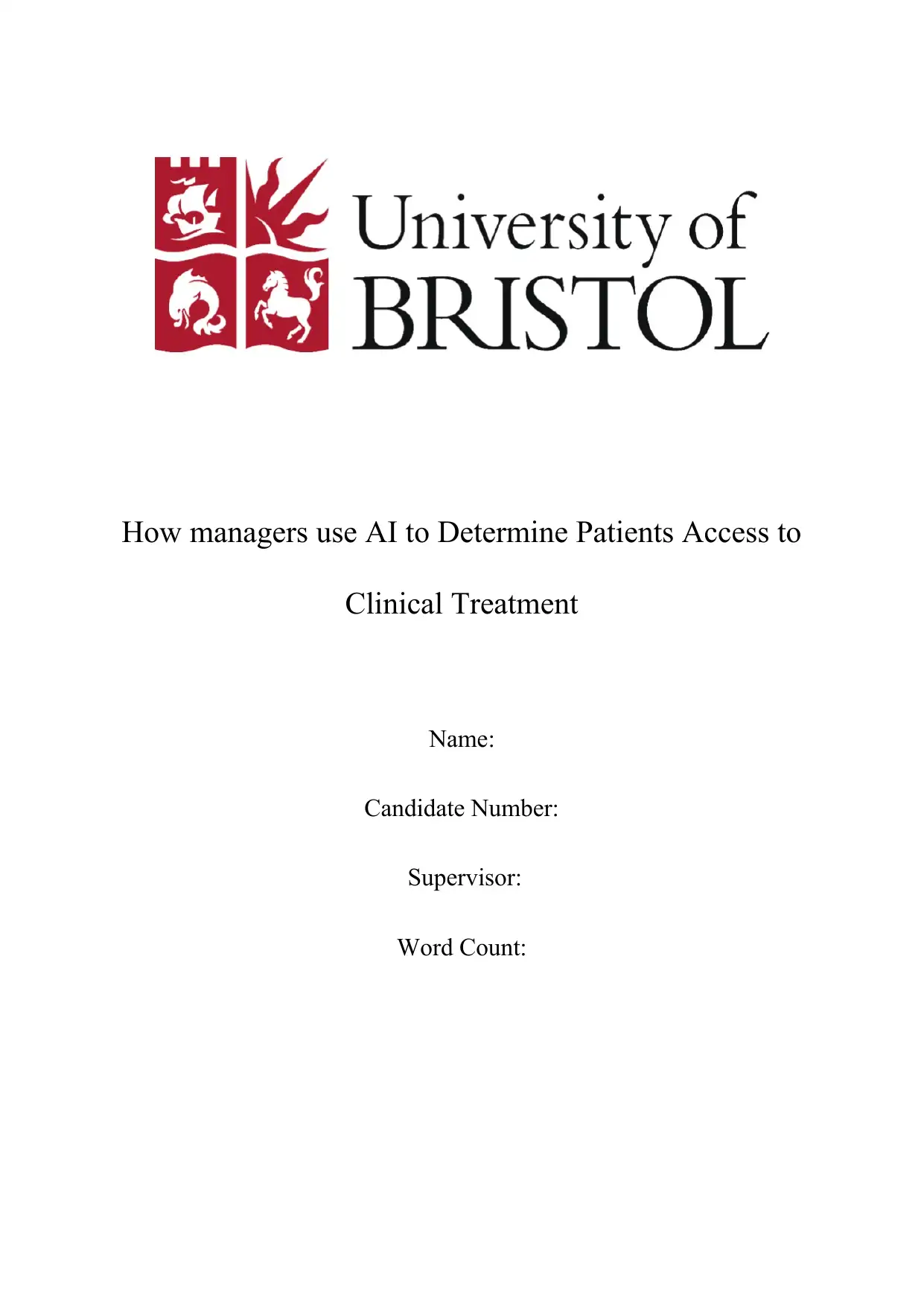
How managers use AI to Determine Patients Access to
Clinical Treatment
Name:
Candidate Number:
Supervisor:
Word Count:
Clinical Treatment
Name:
Candidate Number:
Supervisor:
Word Count:
Paraphrase This Document
Need a fresh take? Get an instant paraphrase of this document with our AI Paraphraser
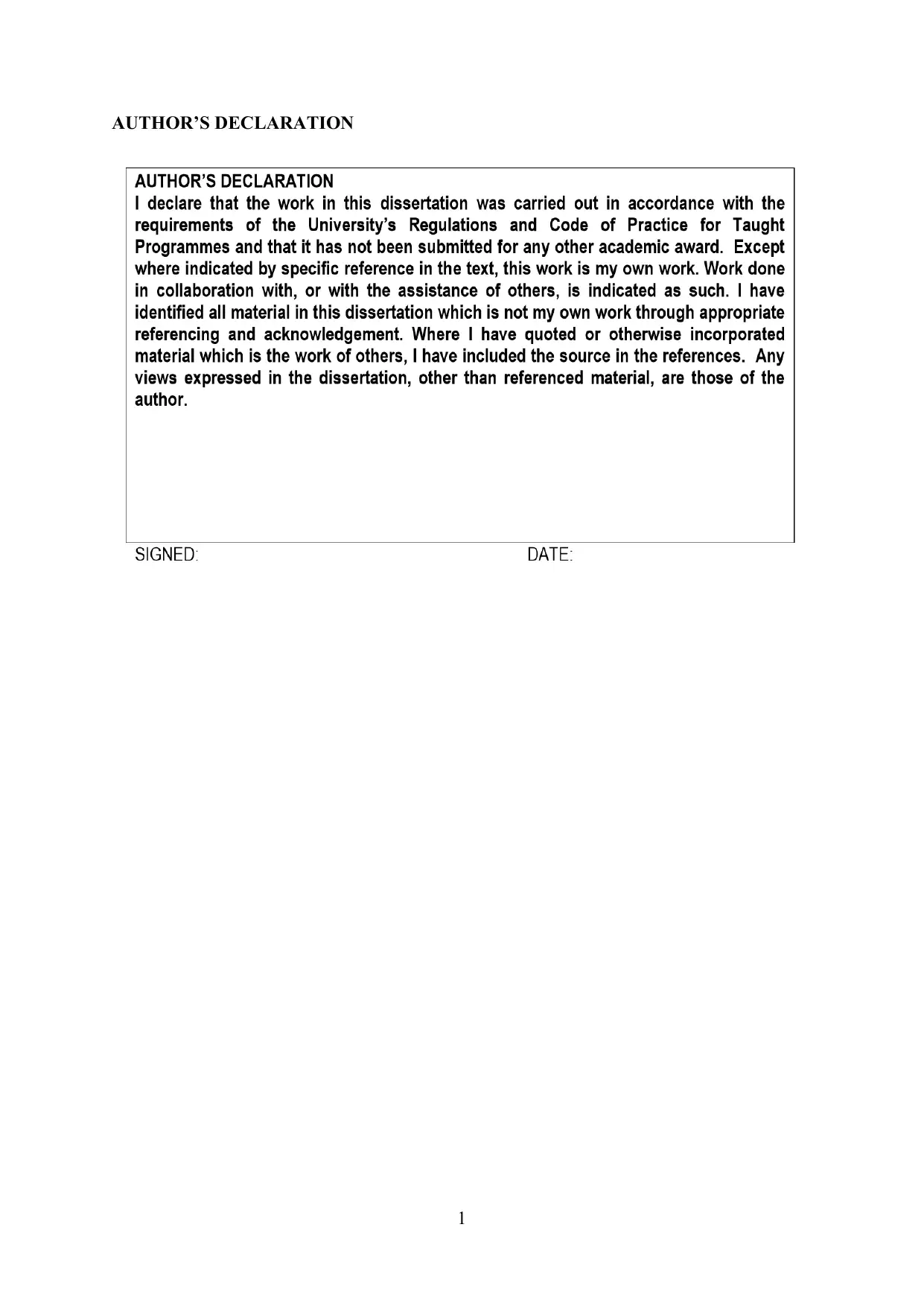
AUTHOR’S DECLARATION
1
1
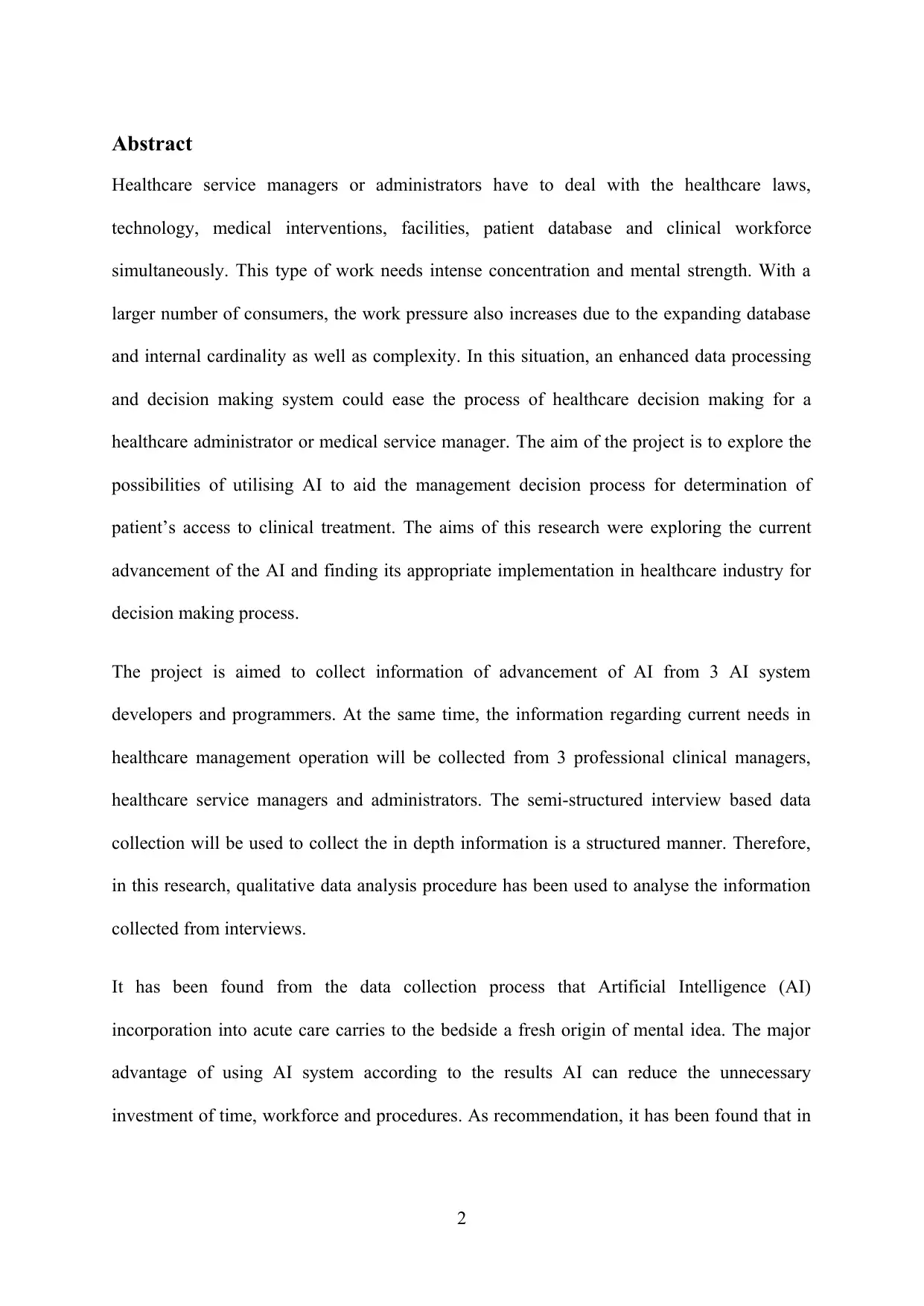
Abstract
Healthcare service managers or administrators have to deal with the healthcare laws,
technology, medical interventions, facilities, patient database and clinical workforce
simultaneously. This type of work needs intense concentration and mental strength. With a
larger number of consumers, the work pressure also increases due to the expanding database
and internal cardinality as well as complexity. In this situation, an enhanced data processing
and decision making system could ease the process of healthcare decision making for a
healthcare administrator or medical service manager. The aim of the project is to explore the
possibilities of utilising AI to aid the management decision process for determination of
patient’s access to clinical treatment. The aims of this research were exploring the current
advancement of the AI and finding its appropriate implementation in healthcare industry for
decision making process.
The project is aimed to collect information of advancement of AI from 3 AI system
developers and programmers. At the same time, the information regarding current needs in
healthcare management operation will be collected from 3 professional clinical managers,
healthcare service managers and administrators. The semi-structured interview based data
collection will be used to collect the in depth information is a structured manner. Therefore,
in this research, qualitative data analysis procedure has been used to analyse the information
collected from interviews.
It has been found from the data collection process that Artificial Intelligence (AI)
incorporation into acute care carries to the bedside a fresh origin of mental idea. The major
advantage of using AI system according to the results AI can reduce the unnecessary
investment of time, workforce and procedures. As recommendation, it has been found that in
2
Healthcare service managers or administrators have to deal with the healthcare laws,
technology, medical interventions, facilities, patient database and clinical workforce
simultaneously. This type of work needs intense concentration and mental strength. With a
larger number of consumers, the work pressure also increases due to the expanding database
and internal cardinality as well as complexity. In this situation, an enhanced data processing
and decision making system could ease the process of healthcare decision making for a
healthcare administrator or medical service manager. The aim of the project is to explore the
possibilities of utilising AI to aid the management decision process for determination of
patient’s access to clinical treatment. The aims of this research were exploring the current
advancement of the AI and finding its appropriate implementation in healthcare industry for
decision making process.
The project is aimed to collect information of advancement of AI from 3 AI system
developers and programmers. At the same time, the information regarding current needs in
healthcare management operation will be collected from 3 professional clinical managers,
healthcare service managers and administrators. The semi-structured interview based data
collection will be used to collect the in depth information is a structured manner. Therefore,
in this research, qualitative data analysis procedure has been used to analyse the information
collected from interviews.
It has been found from the data collection process that Artificial Intelligence (AI)
incorporation into acute care carries to the bedside a fresh origin of mental idea. The major
advantage of using AI system according to the results AI can reduce the unnecessary
investment of time, workforce and procedures. As recommendation, it has been found that in
2
⊘ This is a preview!⊘
Do you want full access?
Subscribe today to unlock all pages.

Trusted by 1+ million students worldwide
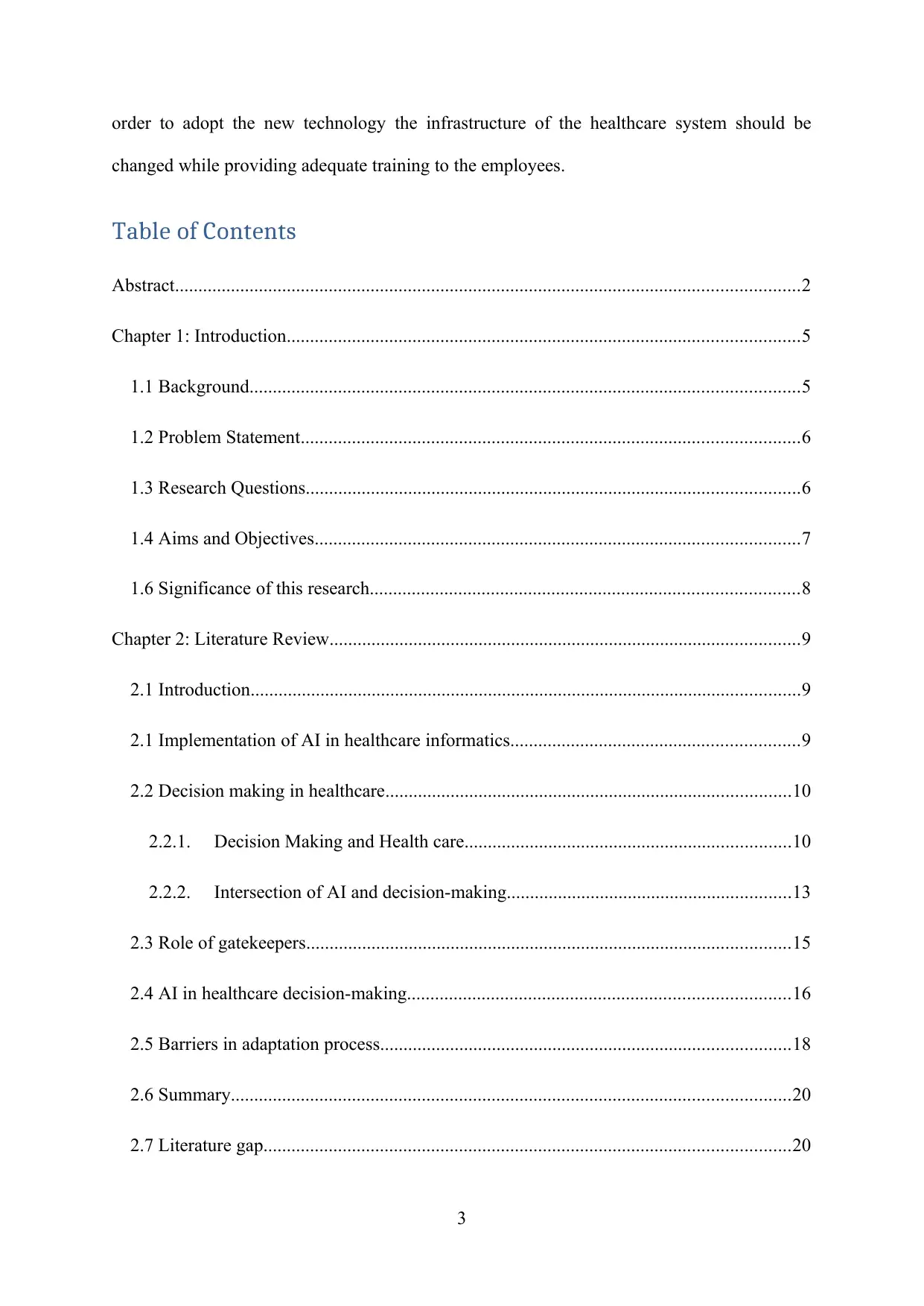
order to adopt the new technology the infrastructure of the healthcare system should be
changed while providing adequate training to the employees.
Table of Contents
Abstract......................................................................................................................................2
Chapter 1: Introduction..............................................................................................................5
1.1 Background......................................................................................................................5
1.2 Problem Statement...........................................................................................................6
1.3 Research Questions..........................................................................................................6
1.4 Aims and Objectives........................................................................................................7
1.6 Significance of this research............................................................................................8
Chapter 2: Literature Review.....................................................................................................9
2.1 Introduction......................................................................................................................9
2.1 Implementation of AI in healthcare informatics..............................................................9
2.2 Decision making in healthcare.......................................................................................10
2.2.1. Decision Making and Health care......................................................................10
2.2.2. Intersection of AI and decision-making.............................................................13
2.3 Role of gatekeepers........................................................................................................15
2.4 AI in healthcare decision-making..................................................................................16
2.5 Barriers in adaptation process........................................................................................18
2.6 Summary........................................................................................................................20
2.7 Literature gap.................................................................................................................20
3
changed while providing adequate training to the employees.
Table of Contents
Abstract......................................................................................................................................2
Chapter 1: Introduction..............................................................................................................5
1.1 Background......................................................................................................................5
1.2 Problem Statement...........................................................................................................6
1.3 Research Questions..........................................................................................................6
1.4 Aims and Objectives........................................................................................................7
1.6 Significance of this research............................................................................................8
Chapter 2: Literature Review.....................................................................................................9
2.1 Introduction......................................................................................................................9
2.1 Implementation of AI in healthcare informatics..............................................................9
2.2 Decision making in healthcare.......................................................................................10
2.2.1. Decision Making and Health care......................................................................10
2.2.2. Intersection of AI and decision-making.............................................................13
2.3 Role of gatekeepers........................................................................................................15
2.4 AI in healthcare decision-making..................................................................................16
2.5 Barriers in adaptation process........................................................................................18
2.6 Summary........................................................................................................................20
2.7 Literature gap.................................................................................................................20
3
Paraphrase This Document
Need a fresh take? Get an instant paraphrase of this document with our AI Paraphraser

Chapter 3: Methodology..........................................................................................................21
3.1 Introduction....................................................................................................................21
3.2 Research Design.............................................................................................................21
3.3 Data collection...............................................................................................................22
3.4 Data analysis..................................................................................................................23
3.5 Ethical Consideration.....................................................................................................24
3.6 Summary........................................................................................................................24
Chapter 4: Data analysis and findings......................................................................................25
4.1 Introduction:...................................................................................................................25
4.2 Grounded theory Map....................................................................................................25
Test for difference in coverage............................................................................................39
Response to Research Instruments.......................................................................................40
4.3 Code frequency..........................................................................................................40
Responses to Questionnaire.............................................................................................41
Responses.........................................................................................................................41
4.4 Discussion......................................................................................................................45
Growth of AI....................................................................................................................45
Role of AI.........................................................................................................................46
4.5 Summary........................................................................................................................48
Rationale for Choosing to research AI in healthcare Gatekeeping and choice of
constituency......................................................................................................................49
Significance of results..........................................................................................................49
4
3.1 Introduction....................................................................................................................21
3.2 Research Design.............................................................................................................21
3.3 Data collection...............................................................................................................22
3.4 Data analysis..................................................................................................................23
3.5 Ethical Consideration.....................................................................................................24
3.6 Summary........................................................................................................................24
Chapter 4: Data analysis and findings......................................................................................25
4.1 Introduction:...................................................................................................................25
4.2 Grounded theory Map....................................................................................................25
Test for difference in coverage............................................................................................39
Response to Research Instruments.......................................................................................40
4.3 Code frequency..........................................................................................................40
Responses to Questionnaire.............................................................................................41
Responses.........................................................................................................................41
4.4 Discussion......................................................................................................................45
Growth of AI....................................................................................................................45
Role of AI.........................................................................................................................46
4.5 Summary........................................................................................................................48
Rationale for Choosing to research AI in healthcare Gatekeeping and choice of
constituency......................................................................................................................49
Significance of results..........................................................................................................49
4
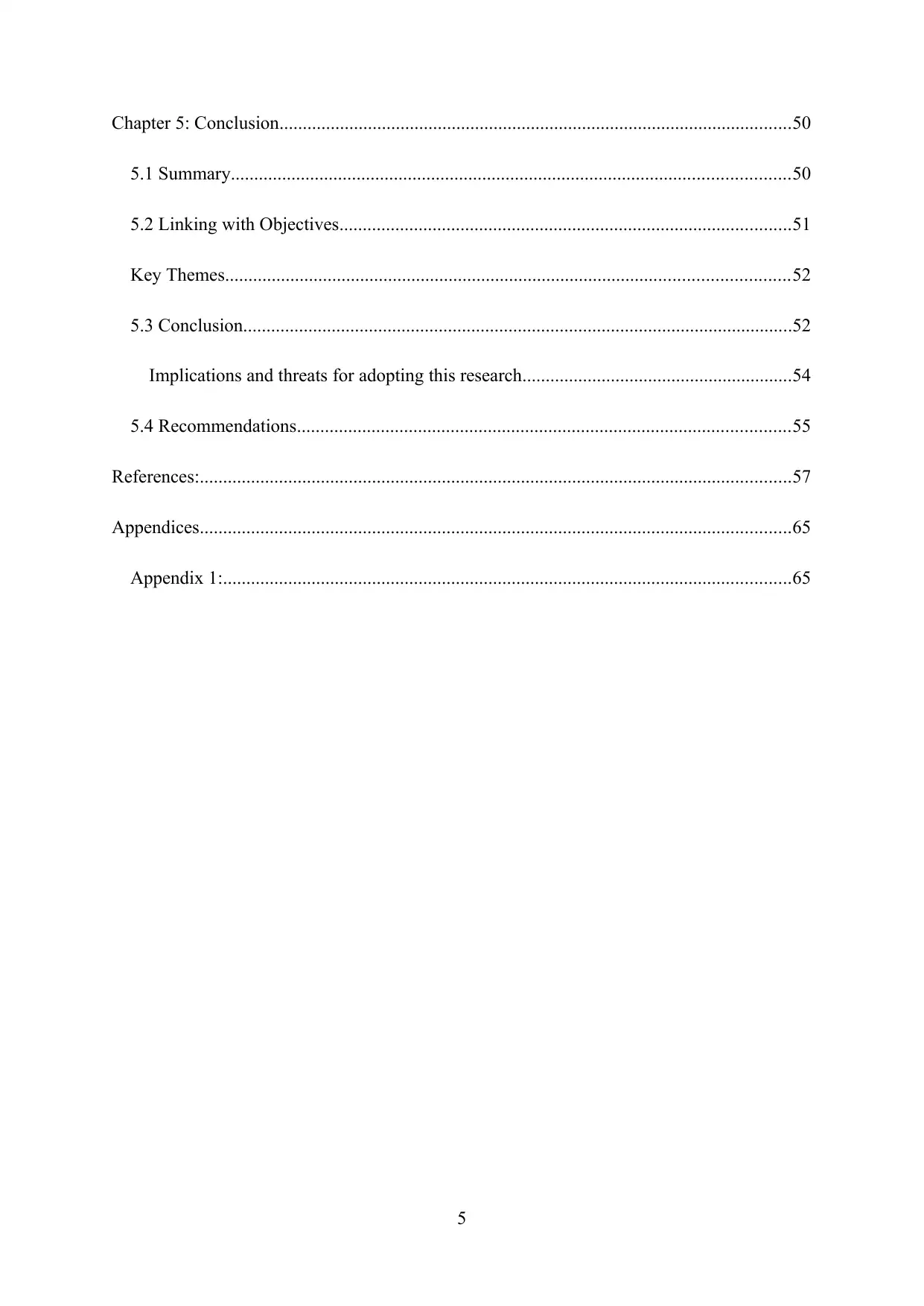
Chapter 5: Conclusion..............................................................................................................50
5.1 Summary........................................................................................................................50
5.2 Linking with Objectives.................................................................................................51
Key Themes.........................................................................................................................52
5.3 Conclusion......................................................................................................................52
Implications and threats for adopting this research..........................................................54
5.4 Recommendations..........................................................................................................55
References:...............................................................................................................................57
Appendices...............................................................................................................................65
Appendix 1:..........................................................................................................................65
5
5.1 Summary........................................................................................................................50
5.2 Linking with Objectives.................................................................................................51
Key Themes.........................................................................................................................52
5.3 Conclusion......................................................................................................................52
Implications and threats for adopting this research..........................................................54
5.4 Recommendations..........................................................................................................55
References:...............................................................................................................................57
Appendices...............................................................................................................................65
Appendix 1:..........................................................................................................................65
5
⊘ This is a preview!⊘
Do you want full access?
Subscribe today to unlock all pages.

Trusted by 1+ million students worldwide
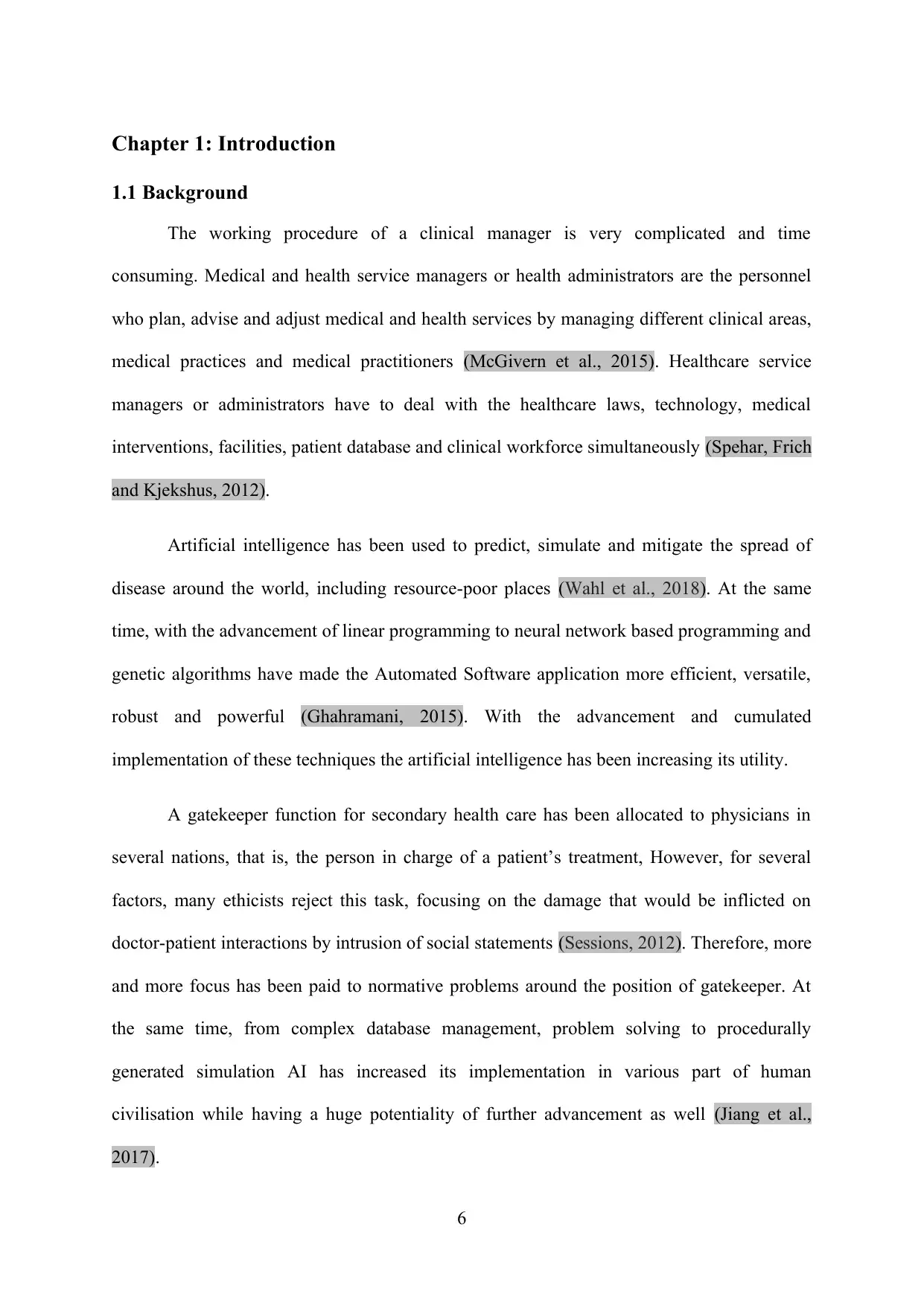
Chapter 1: Introduction
1.1 Background
The working procedure of a clinical manager is very complicated and time
consuming. Medical and health service managers or health administrators are the personnel
who plan, advise and adjust medical and health services by managing different clinical areas,
medical practices and medical practitioners (McGivern et al., 2015). Healthcare service
managers or administrators have to deal with the healthcare laws, technology, medical
interventions, facilities, patient database and clinical workforce simultaneously (Spehar, Frich
and Kjekshus, 2012).
Artificial intelligence has been used to predict, simulate and mitigate the spread of
disease around the world, including resource-poor places (Wahl et al., 2018). At the same
time, with the advancement of linear programming to neural network based programming and
genetic algorithms have made the Automated Software application more efficient, versatile,
robust and powerful (Ghahramani, 2015). With the advancement and cumulated
implementation of these techniques the artificial intelligence has been increasing its utility.
A gatekeeper function for secondary health care has been allocated to physicians in
several nations, that is, the person in charge of a patient’s treatment, However, for several
factors, many ethicists reject this task, focusing on the damage that would be inflicted on
doctor-patient interactions by intrusion of social statements (Sessions, 2012). Therefore, more
and more focus has been paid to normative problems around the position of gatekeeper. At
the same time, from complex database management, problem solving to procedurally
generated simulation AI has increased its implementation in various part of human
civilisation while having a huge potentiality of further advancement as well (Jiang et al.,
2017).
6
1.1 Background
The working procedure of a clinical manager is very complicated and time
consuming. Medical and health service managers or health administrators are the personnel
who plan, advise and adjust medical and health services by managing different clinical areas,
medical practices and medical practitioners (McGivern et al., 2015). Healthcare service
managers or administrators have to deal with the healthcare laws, technology, medical
interventions, facilities, patient database and clinical workforce simultaneously (Spehar, Frich
and Kjekshus, 2012).
Artificial intelligence has been used to predict, simulate and mitigate the spread of
disease around the world, including resource-poor places (Wahl et al., 2018). At the same
time, with the advancement of linear programming to neural network based programming and
genetic algorithms have made the Automated Software application more efficient, versatile,
robust and powerful (Ghahramani, 2015). With the advancement and cumulated
implementation of these techniques the artificial intelligence has been increasing its utility.
A gatekeeper function for secondary health care has been allocated to physicians in
several nations, that is, the person in charge of a patient’s treatment, However, for several
factors, many ethicists reject this task, focusing on the damage that would be inflicted on
doctor-patient interactions by intrusion of social statements (Sessions, 2012). Therefore, more
and more focus has been paid to normative problems around the position of gatekeeper. At
the same time, from complex database management, problem solving to procedurally
generated simulation AI has increased its implementation in various part of human
civilisation while having a huge potentiality of further advancement as well (Jiang et al.,
2017).
6
Paraphrase This Document
Need a fresh take? Get an instant paraphrase of this document with our AI Paraphraser
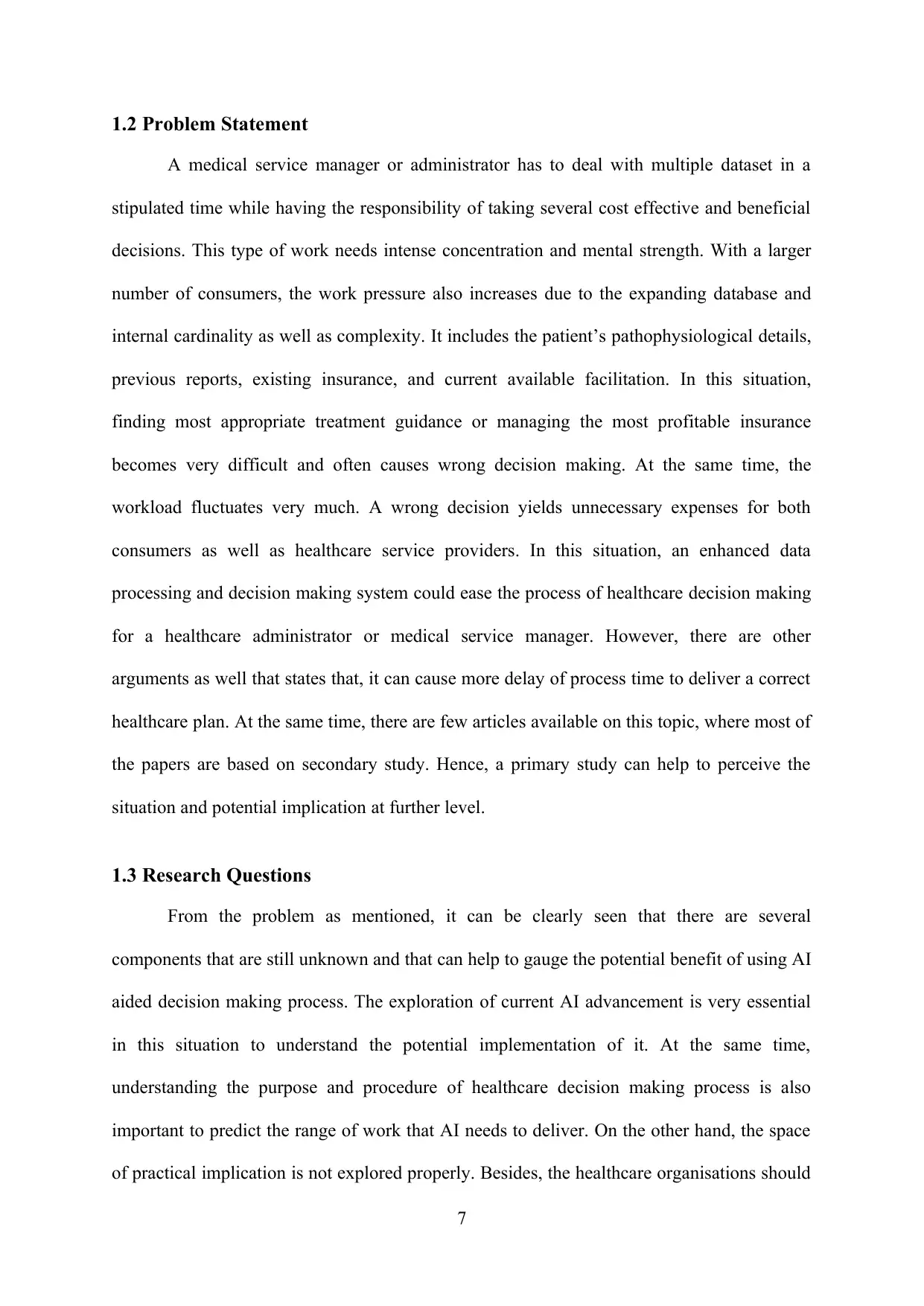
1.2 Problem Statement
A medical service manager or administrator has to deal with multiple dataset in a
stipulated time while having the responsibility of taking several cost effective and beneficial
decisions. This type of work needs intense concentration and mental strength. With a larger
number of consumers, the work pressure also increases due to the expanding database and
internal cardinality as well as complexity. It includes the patient’s pathophysiological details,
previous reports, existing insurance, and current available facilitation. In this situation,
finding most appropriate treatment guidance or managing the most profitable insurance
becomes very difficult and often causes wrong decision making. At the same time, the
workload fluctuates very much. A wrong decision yields unnecessary expenses for both
consumers as well as healthcare service providers. In this situation, an enhanced data
processing and decision making system could ease the process of healthcare decision making
for a healthcare administrator or medical service manager. However, there are other
arguments as well that states that, it can cause more delay of process time to deliver a correct
healthcare plan. At the same time, there are few articles available on this topic, where most of
the papers are based on secondary study. Hence, a primary study can help to perceive the
situation and potential implication at further level.
1.3 Research Questions
From the problem as mentioned, it can be clearly seen that there are several
components that are still unknown and that can help to gauge the potential benefit of using AI
aided decision making process. The exploration of current AI advancement is very essential
in this situation to understand the potential implementation of it. At the same time,
understanding the purpose and procedure of healthcare decision making process is also
important to predict the range of work that AI needs to deliver. On the other hand, the space
of practical implication is not explored properly. Besides, the healthcare organisations should
7
A medical service manager or administrator has to deal with multiple dataset in a
stipulated time while having the responsibility of taking several cost effective and beneficial
decisions. This type of work needs intense concentration and mental strength. With a larger
number of consumers, the work pressure also increases due to the expanding database and
internal cardinality as well as complexity. It includes the patient’s pathophysiological details,
previous reports, existing insurance, and current available facilitation. In this situation,
finding most appropriate treatment guidance or managing the most profitable insurance
becomes very difficult and often causes wrong decision making. At the same time, the
workload fluctuates very much. A wrong decision yields unnecessary expenses for both
consumers as well as healthcare service providers. In this situation, an enhanced data
processing and decision making system could ease the process of healthcare decision making
for a healthcare administrator or medical service manager. However, there are other
arguments as well that states that, it can cause more delay of process time to deliver a correct
healthcare plan. At the same time, there are few articles available on this topic, where most of
the papers are based on secondary study. Hence, a primary study can help to perceive the
situation and potential implication at further level.
1.3 Research Questions
From the problem as mentioned, it can be clearly seen that there are several
components that are still unknown and that can help to gauge the potential benefit of using AI
aided decision making process. The exploration of current AI advancement is very essential
in this situation to understand the potential implementation of it. At the same time,
understanding the purpose and procedure of healthcare decision making process is also
important to predict the range of work that AI needs to deliver. On the other hand, the space
of practical implication is not explored properly. Besides, the healthcare organisations should
7
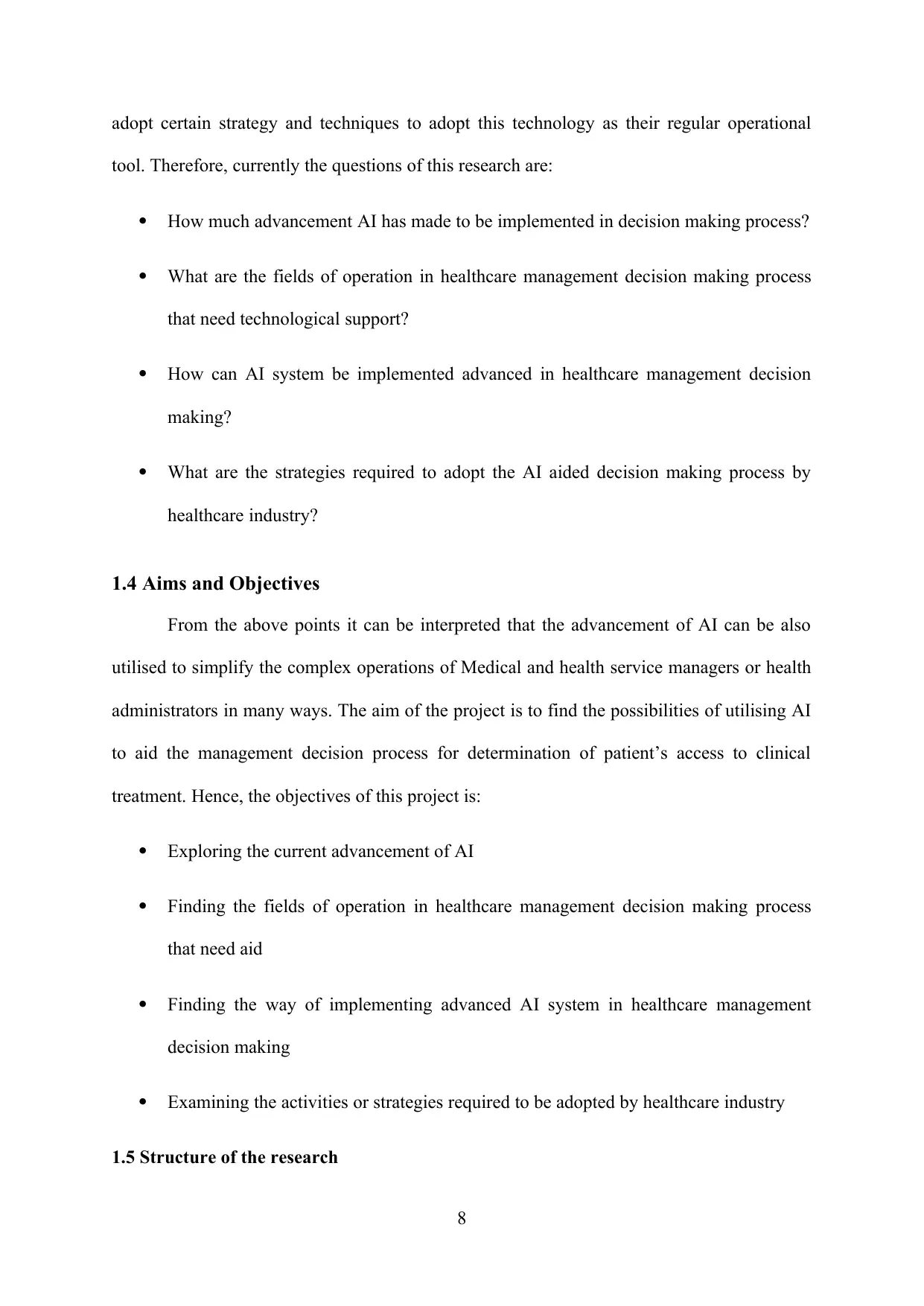
adopt certain strategy and techniques to adopt this technology as their regular operational
tool. Therefore, currently the questions of this research are:
How much advancement AI has made to be implemented in decision making process?
What are the fields of operation in healthcare management decision making process
that need technological support?
How can AI system be implemented advanced in healthcare management decision
making?
What are the strategies required to adopt the AI aided decision making process by
healthcare industry?
1.4 Aims and Objectives
From the above points it can be interpreted that the advancement of AI can be also
utilised to simplify the complex operations of Medical and health service managers or health
administrators in many ways. The aim of the project is to find the possibilities of utilising AI
to aid the management decision process for determination of patient’s access to clinical
treatment. Hence, the objectives of this project is:
Exploring the current advancement of AI
Finding the fields of operation in healthcare management decision making process
that need aid
Finding the way of implementing advanced AI system in healthcare management
decision making
Examining the activities or strategies required to be adopted by healthcare industry
1.5 Structure of the research
8
tool. Therefore, currently the questions of this research are:
How much advancement AI has made to be implemented in decision making process?
What are the fields of operation in healthcare management decision making process
that need technological support?
How can AI system be implemented advanced in healthcare management decision
making?
What are the strategies required to adopt the AI aided decision making process by
healthcare industry?
1.4 Aims and Objectives
From the above points it can be interpreted that the advancement of AI can be also
utilised to simplify the complex operations of Medical and health service managers or health
administrators in many ways. The aim of the project is to find the possibilities of utilising AI
to aid the management decision process for determination of patient’s access to clinical
treatment. Hence, the objectives of this project is:
Exploring the current advancement of AI
Finding the fields of operation in healthcare management decision making process
that need aid
Finding the way of implementing advanced AI system in healthcare management
decision making
Examining the activities or strategies required to be adopted by healthcare industry
1.5 Structure of the research
8
⊘ This is a preview!⊘
Do you want full access?
Subscribe today to unlock all pages.

Trusted by 1+ million students worldwide
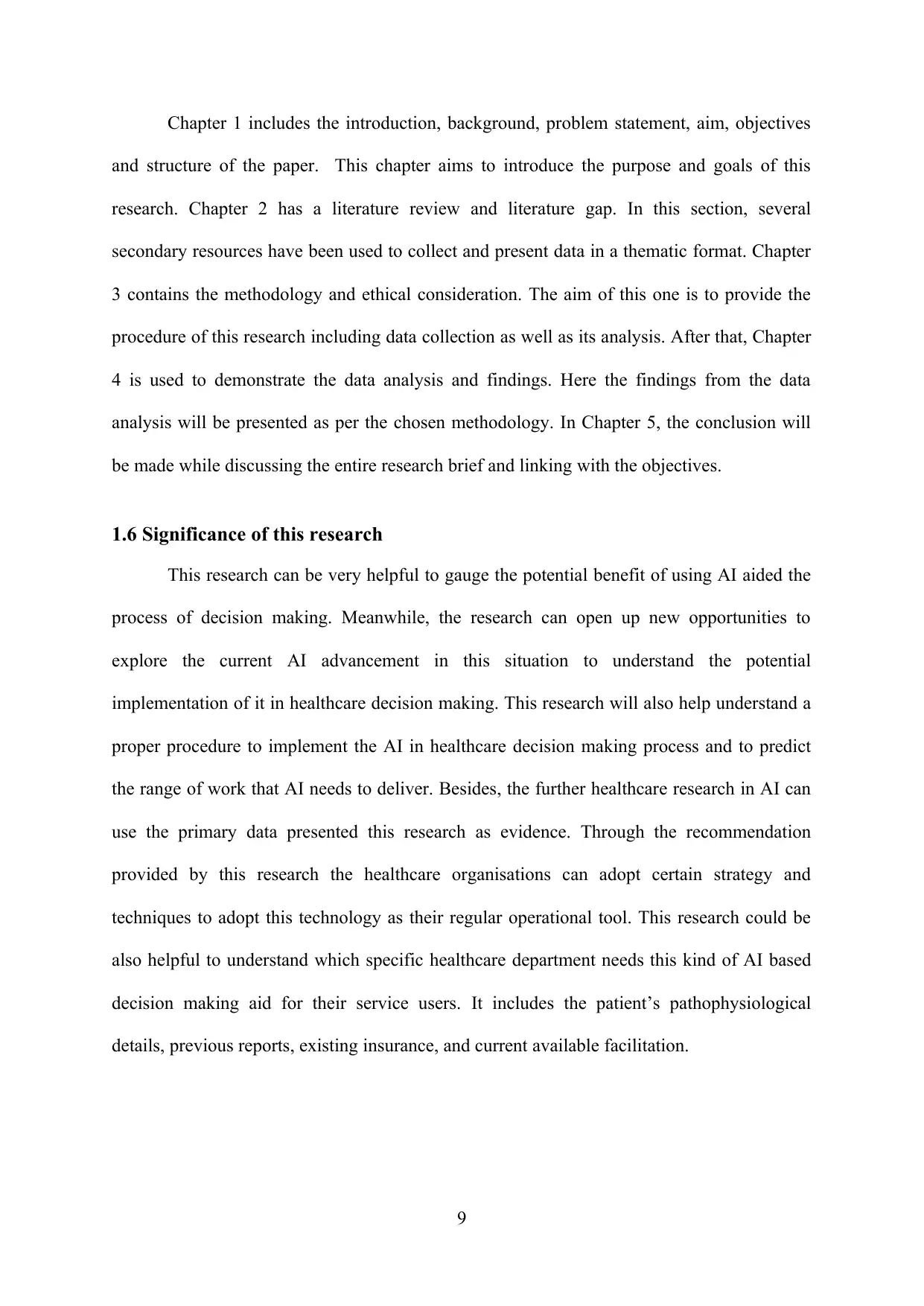
Chapter 1 includes the introduction, background, problem statement, aim, objectives
and structure of the paper. This chapter aims to introduce the purpose and goals of this
research. Chapter 2 has a literature review and literature gap. In this section, several
secondary resources have been used to collect and present data in a thematic format. Chapter
3 contains the methodology and ethical consideration. The aim of this one is to provide the
procedure of this research including data collection as well as its analysis. After that, Chapter
4 is used to demonstrate the data analysis and findings. Here the findings from the data
analysis will be presented as per the chosen methodology. In Chapter 5, the conclusion will
be made while discussing the entire research brief and linking with the objectives.
1.6 Significance of this research
This research can be very helpful to gauge the potential benefit of using AI aided the
process of decision making. Meanwhile, the research can open up new opportunities to
explore the current AI advancement in this situation to understand the potential
implementation of it in healthcare decision making. This research will also help understand a
proper procedure to implement the AI in healthcare decision making process and to predict
the range of work that AI needs to deliver. Besides, the further healthcare research in AI can
use the primary data presented this research as evidence. Through the recommendation
provided by this research the healthcare organisations can adopt certain strategy and
techniques to adopt this technology as their regular operational tool. This research could be
also helpful to understand which specific healthcare department needs this kind of AI based
decision making aid for their service users. It includes the patient’s pathophysiological
details, previous reports, existing insurance, and current available facilitation.
9
and structure of the paper. This chapter aims to introduce the purpose and goals of this
research. Chapter 2 has a literature review and literature gap. In this section, several
secondary resources have been used to collect and present data in a thematic format. Chapter
3 contains the methodology and ethical consideration. The aim of this one is to provide the
procedure of this research including data collection as well as its analysis. After that, Chapter
4 is used to demonstrate the data analysis and findings. Here the findings from the data
analysis will be presented as per the chosen methodology. In Chapter 5, the conclusion will
be made while discussing the entire research brief and linking with the objectives.
1.6 Significance of this research
This research can be very helpful to gauge the potential benefit of using AI aided the
process of decision making. Meanwhile, the research can open up new opportunities to
explore the current AI advancement in this situation to understand the potential
implementation of it in healthcare decision making. This research will also help understand a
proper procedure to implement the AI in healthcare decision making process and to predict
the range of work that AI needs to deliver. Besides, the further healthcare research in AI can
use the primary data presented this research as evidence. Through the recommendation
provided by this research the healthcare organisations can adopt certain strategy and
techniques to adopt this technology as their regular operational tool. This research could be
also helpful to understand which specific healthcare department needs this kind of AI based
decision making aid for their service users. It includes the patient’s pathophysiological
details, previous reports, existing insurance, and current available facilitation.
9
Paraphrase This Document
Need a fresh take? Get an instant paraphrase of this document with our AI Paraphraser
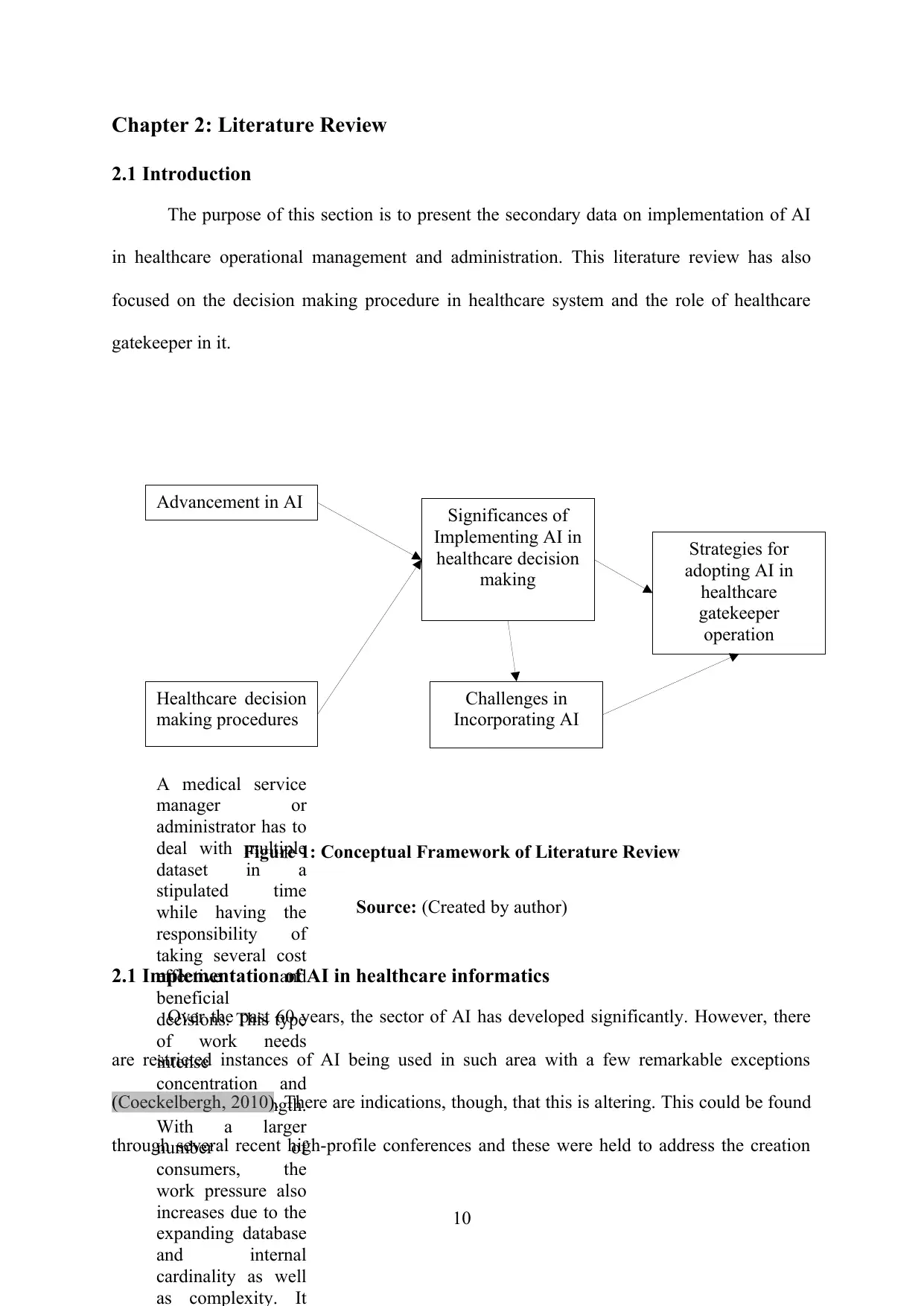
Advancement in AI
Healthcare decision
making procedures
A medical service
manager or
administrator has to
deal with multiple
dataset in a
stipulated time
while having the
responsibility of
taking several cost
effective and
beneficial
decisions. This type
of work needs
intense
concentration and
mental strength.
With a larger
number of
consumers, the
work pressure also
increases due to the
expanding database
and internal
cardinality as well
as complexity. It
Significances of
Implementing AI in
healthcare decision
making
Strategies for
adopting AI in
healthcare
gatekeeper
operation
Challenges in
Incorporating AI
Chapter 2: Literature Review
2.1 Introduction
The purpose of this section is to present the secondary data on implementation of AI
in healthcare operational management and administration. This literature review has also
focused on the decision making procedure in healthcare system and the role of healthcare
gatekeeper in it.
Figure 1: Conceptual Framework of Literature Review
Source: (Created by author)
2.1 Implementation of AI in healthcare informatics
Over the past 60 years, the sector of AI has developed significantly. However, there
are restricted instances of AI being used in such area with a few remarkable exceptions
(Coeckelbergh, 2010). There are indications, though, that this is altering. This could be found
through several recent high-profile conferences and these were held to address the creation
10
Healthcare decision
making procedures
A medical service
manager or
administrator has to
deal with multiple
dataset in a
stipulated time
while having the
responsibility of
taking several cost
effective and
beneficial
decisions. This type
of work needs
intense
concentration and
mental strength.
With a larger
number of
consumers, the
work pressure also
increases due to the
expanding database
and internal
cardinality as well
as complexity. It
Significances of
Implementing AI in
healthcare decision
making
Strategies for
adopting AI in
healthcare
gatekeeper
operation
Challenges in
Incorporating AI
Chapter 2: Literature Review
2.1 Introduction
The purpose of this section is to present the secondary data on implementation of AI
in healthcare operational management and administration. This literature review has also
focused on the decision making procedure in healthcare system and the role of healthcare
gatekeeper in it.
Figure 1: Conceptual Framework of Literature Review
Source: (Created by author)
2.1 Implementation of AI in healthcare informatics
Over the past 60 years, the sector of AI has developed significantly. However, there
are restricted instances of AI being used in such area with a few remarkable exceptions
(Coeckelbergh, 2010). There are indications, though, that this is altering. This could be found
through several recent high-profile conferences and these were held to address the creation
10
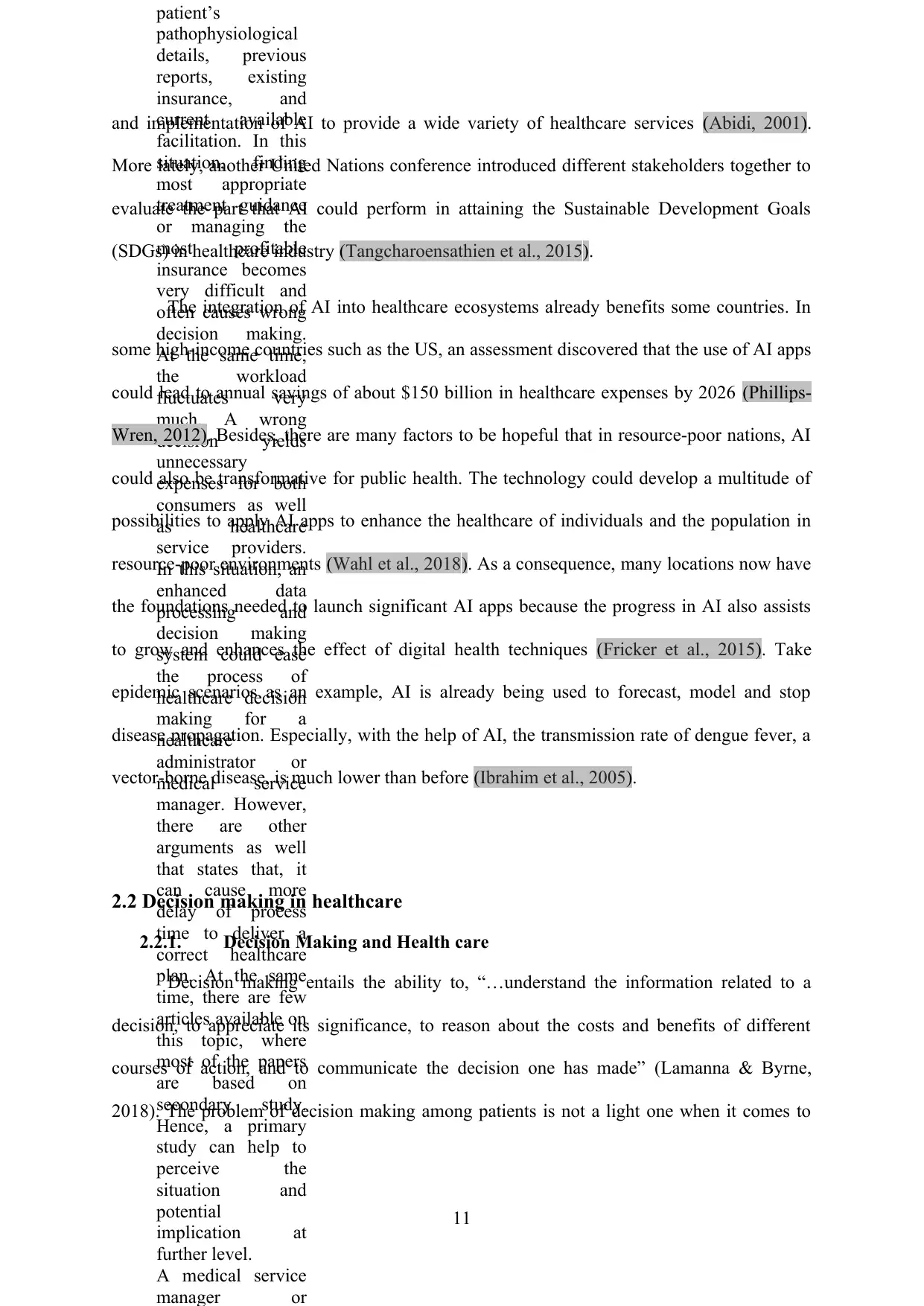
patient’s
pathophysiological
details, previous
reports, existing
insurance, and
current available
facilitation. In this
situation, finding
most appropriate
treatment guidance
or managing the
most profitable
insurance becomes
very difficult and
often causes wrong
decision making.
At the same time,
the workload
fluctuates very
much. A wrong
decision yields
unnecessary
expenses for both
consumers as well
as healthcare
service providers.
In this situation, an
enhanced data
processing and
decision making
system could ease
the process of
healthcare decision
making for a
healthcare
administrator or
medical service
manager. However,
there are other
arguments as well
that states that, it
can cause more
delay of process
time to deliver a
correct healthcare
plan. At the same
time, there are few
articles available on
this topic, where
most of the papers
are based on
secondary study.
Hence, a primary
study can help to
perceive the
situation and
potential
implication at
further level.
A medical service
manager or
and implementation of AI to provide a wide variety of healthcare services (Abidi, 2001).
More lately, another United Nations conference introduced different stakeholders together to
evaluate the part that AI could perform in attaining the Sustainable Development Goals
(SDGs) in healthcare industry (Tangcharoensathien et al., 2015).
The integration of AI into healthcare ecosystems already benefits some countries. In
some high-income countries such as the US, an assessment discovered that the use of AI apps
could lead to annual savings of about $150 billion in healthcare expenses by 2026 (Phillips-
Wren, 2012). Besides, there are many factors to be hopeful that in resource-poor nations, AI
could also be transformative for public health. The technology could develop a multitude of
possibilities to apply AI apps to enhance the healthcare of individuals and the population in
resource-poor environments (Wahl et al., 2018). As a consequence, many locations now have
the foundations needed to launch significant AI apps because the progress in AI also assists
to grow and enhances the effect of digital health techniques (Fricker et al., 2015). Take
epidemic scenarios as an example, AI is already being used to forecast, model and stop
disease propagation. Especially, with the help of AI, the transmission rate of dengue fever, a
vector-borne disease, is much lower than before (Ibrahim et al., 2005).
2.2 Decision making in healthcare
2.2.1. Decision Making and Health care
Decision making entails the ability to, “…understand the information related to a
decision, to appreciate its significance, to reason about the costs and benefits of different
courses of action, and to communicate the decision one has made” (Lamanna & Byrne,
2018). The problem of decision making among patients is not a light one when it comes to
11
pathophysiological
details, previous
reports, existing
insurance, and
current available
facilitation. In this
situation, finding
most appropriate
treatment guidance
or managing the
most profitable
insurance becomes
very difficult and
often causes wrong
decision making.
At the same time,
the workload
fluctuates very
much. A wrong
decision yields
unnecessary
expenses for both
consumers as well
as healthcare
service providers.
In this situation, an
enhanced data
processing and
decision making
system could ease
the process of
healthcare decision
making for a
healthcare
administrator or
medical service
manager. However,
there are other
arguments as well
that states that, it
can cause more
delay of process
time to deliver a
correct healthcare
plan. At the same
time, there are few
articles available on
this topic, where
most of the papers
are based on
secondary study.
Hence, a primary
study can help to
perceive the
situation and
potential
implication at
further level.
A medical service
manager or
and implementation of AI to provide a wide variety of healthcare services (Abidi, 2001).
More lately, another United Nations conference introduced different stakeholders together to
evaluate the part that AI could perform in attaining the Sustainable Development Goals
(SDGs) in healthcare industry (Tangcharoensathien et al., 2015).
The integration of AI into healthcare ecosystems already benefits some countries. In
some high-income countries such as the US, an assessment discovered that the use of AI apps
could lead to annual savings of about $150 billion in healthcare expenses by 2026 (Phillips-
Wren, 2012). Besides, there are many factors to be hopeful that in resource-poor nations, AI
could also be transformative for public health. The technology could develop a multitude of
possibilities to apply AI apps to enhance the healthcare of individuals and the population in
resource-poor environments (Wahl et al., 2018). As a consequence, many locations now have
the foundations needed to launch significant AI apps because the progress in AI also assists
to grow and enhances the effect of digital health techniques (Fricker et al., 2015). Take
epidemic scenarios as an example, AI is already being used to forecast, model and stop
disease propagation. Especially, with the help of AI, the transmission rate of dengue fever, a
vector-borne disease, is much lower than before (Ibrahim et al., 2005).
2.2 Decision making in healthcare
2.2.1. Decision Making and Health care
Decision making entails the ability to, “…understand the information related to a
decision, to appreciate its significance, to reason about the costs and benefits of different
courses of action, and to communicate the decision one has made” (Lamanna & Byrne,
2018). The problem of decision making among patients is not a light one when it comes to
11
⊘ This is a preview!⊘
Do you want full access?
Subscribe today to unlock all pages.

Trusted by 1+ million students worldwide
1 out of 72
Related Documents
Your All-in-One AI-Powered Toolkit for Academic Success.
+13062052269
info@desklib.com
Available 24*7 on WhatsApp / Email
![[object Object]](/_next/static/media/star-bottom.7253800d.svg)
Unlock your academic potential
Copyright © 2020–2025 A2Z Services. All Rights Reserved. Developed and managed by ZUCOL.





